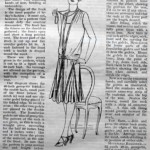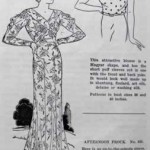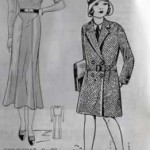Between 1880 and 1939 there was a decline in restrictive dress such as corsets, along with dress reform encouraging women to wear more natural, comfortable clothing. Unskirted garments such as trousers went from being frowned upon to being iconic of the ‘Roaring Twenties’ and beyond. Shorter hairstyles were also favoured and fashions were mimicked by using paper patterns to create your own clothing. By the 1920s such patterns were widely available through women’s magazines and, with many working-class women having access to sewing machines, home dressmaking was a way for these women to access the latest, most fashionable designs.
-
Press cutting from Edinburgh Evening News (18 August 1925)
Ellen Wilkinson was a committed trade unionist and one of the first female MPs (taking the seat of Middlesbrough East in 1924). During the interwar years, Wilkinson was involved in a number of campaigns to improve the lives of the working class, notably as leader of the Jarrow Crusade (1936) and in advocating Hire Purchase reform. Press interest focused not only on her politics, but also on her appearance. For example, it was custom to wear dark colours in parliament and she caused quite a stir in the press when wearing a homemade green dress.
-
Jumper Suit (September 1920)
Paper pattern printed in Labour Woman. Most working class women sewed their own clothes for their families. Labour Woman was the Labour Party’s women magazine for 58 years. The magazine began by covering the fight for the extension of the voting franchise to women.
-
Party Frock (January 1929)
Paper pattern printed in Labour Woman.
-
Fancy Dress Costumes for Dance or Carnival (December 1929)
Paper pattern printed in Labour Woman.
-
Useful Blouse and Afternoon Frock
(June 1933)
Paper pattern printed in Labour Woman.
-
Stylish Frock and Girls Coat (August 1937)
Paper pattern printed in Labour Woman.
-
‘The Importance of Clothes’, piece from British Citizen & Empire Worker
(March 1919)
British Citizen & Empire Worker was a newspaper for supporters of the National Democratic and Labour Party and featured a regular women’s page with ‘tips for the housewife’ including fashion advice.
All of the images and texts published in this virtual exhibition are for private use only and not for copying, reproduction or publication. They are low resolution images only. The copyright holder for these digital images is the People’s History Museum, except for the Tailor’s Notebooks and the National Union of Tailors and Garment Workers (NUTGW) pamphlet which have kindly been contributed by the Working Class Movement Library, Salford. Copyright of the original artwork, photographs or products may be held by the artist, maker, photographer or agent. By choosing to view the collections via this website you have accepted these conditions.
We would like to thank Ingrid Francis (MA Museum Studies, Newcastle University) who has worked on the construction of this virtual exhibition as part of her placement at the People’s History Museum. We would also like to thank the National Co-operative Archives, People’s History Museum and the Working Class Movement Library for permitting items from their collection to be used in this exhibition.






